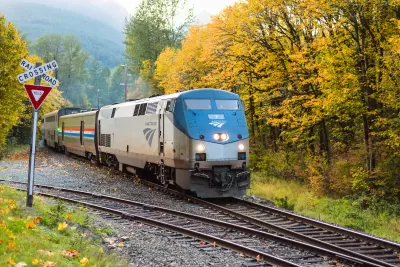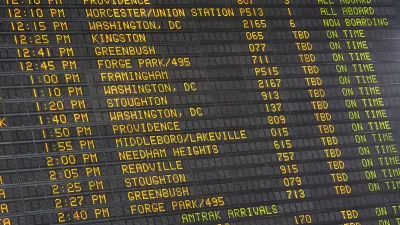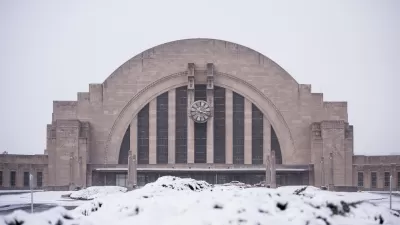The agency wants to add new lines, improve service, and modernize its fleet as part of a $75 billion plan to revive U.S. train travel.

Writing in Bloomberg CityLab, Angie Schmitt outlines what Amtrak’s $75 billion expansion plan could mean for U.S. train travel. “Amtrak’s expansion plan, dubbed Amtrak Connects US, proposes service improvements to 25 existing routes and the addition of 39 entirely new routes. If the vision were to be fully realized, it would bring passenger rail to almost every major city in the US in 15 years.” Today, that number stands at 27 out of 50 largest metro areas served.
Amtrak’s ambitious new plan, Schmitt notes, is “a long way from the giant network of interurban trains that Americans relied on to get around early in the 20th century, but the plan would still mark a dramatic expansion of passenger rail.”
Schmitt describes the proposed expansion, which would include new service in 160 communities in 16 states and restored service in legacy cities like Las Vegas and Columbus. “In Cleveland, Amtrak has proposed turning the Midwest city into a mini-hub, with three daily trips to Detroit; currently, its served just twice daily in the middle of the night.” Schmitt notes, “All US regions would see some improvements, but one of the goals of the plan is to better align service with new population centers in the Sun Belt and US South.”
Funding from the infrastructure bill is also aimed at replacing and modernizing Amtrak’s trains, which will translate into faster and more reliable service as well as conveniences like Wi-Fi and USB ports. “More than delivering truly high-speed rail, Amtrak’s plans focus on improving on-time performance — a chronic challenge given that Amtrak often must share tracks with freight trains — as well as boosting average speeds on the most well-used corridors.”
Ultimately, U.S. train service remains far substandard compared to other countries. “But if a large portion of Amtrak’s plans are realized, it could help return train travel into the mainstream in a way most Americans have never experienced in their lifetimes.”
FULL STORY: What Would an Amtrak Revival Look Like?

Study: Maui’s Plan to Convert Vacation Rentals to Long-Term Housing Could Cause Nearly $1 Billion Economic Loss
The plan would reduce visitor accommodation by 25,% resulting in 1,900 jobs lost.

North Texas Transit Leaders Tout Benefits of TOD for Growing Region
At a summit focused on transit-oriented development, policymakers discussed how North Texas’ expanded light rail system can serve as a tool for economic growth.

Using Old Oil and Gas Wells for Green Energy Storage
Penn State researchers have found that repurposing abandoned oil and gas wells for geothermal-assisted compressed-air energy storage can boost efficiency, reduce environmental risks, and support clean energy and job transitions.

Santa Barbara Could Build Housing on County Land
County supervisors moved forward a proposal to build workforce housing on two county-owned parcels.

San Mateo Formally Opposes Freeway Project
The city council will send a letter to Caltrans urging the agency to reconsider a plan to expand the 101 through the city of San Mateo.

A Bronx Community Fights to Have its Voice Heard
After organizing and giving input for decades, the community around the Kingsbridge Armory might actually see it redeveloped — and they want to continue to have a say in how it goes.
Urban Design for Planners 1: Software Tools
This six-course series explores essential urban design concepts using open source software and equips planners with the tools they need to participate fully in the urban design process.
Planning for Universal Design
Learn the tools for implementing Universal Design in planning regulations.
Ascent Environmental
Borough of Carlisle
Institute for Housing and Urban Development Studies (IHS)
City of Grandview
Harvard GSD Executive Education
Toledo-Lucas County Plan Commissions
Salt Lake City
NYU Wagner Graduate School of Public Service





























